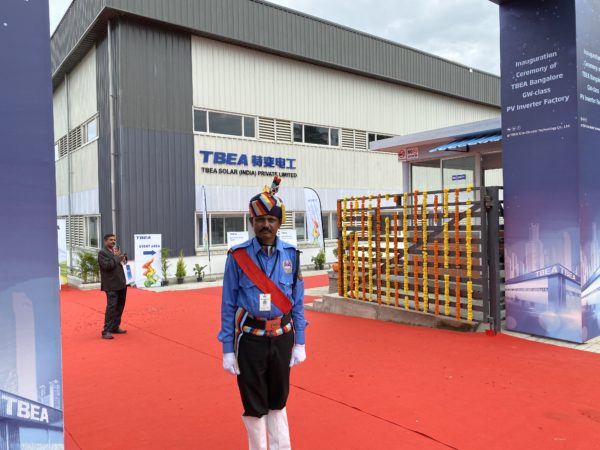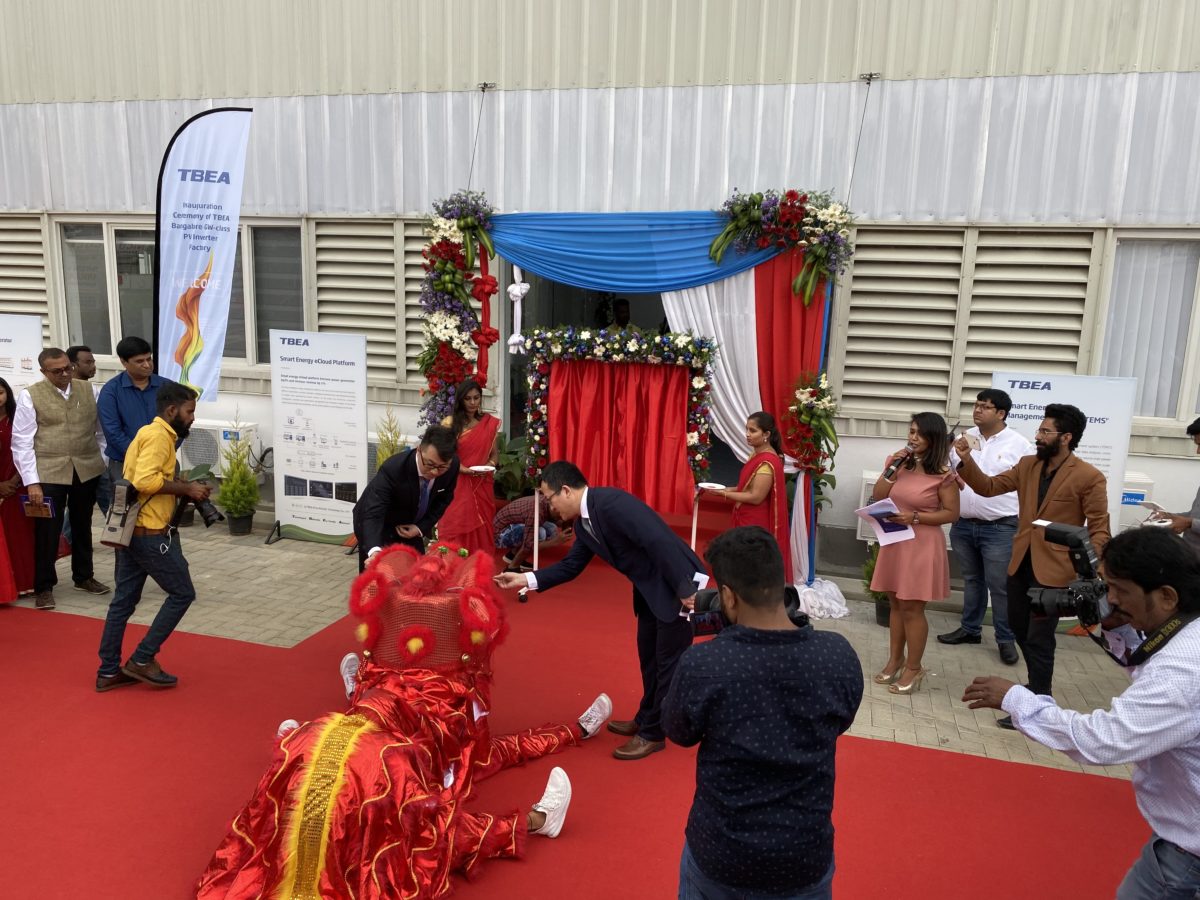TBEA Xinjiang Sunoasis Co., Ltd., part of TBEA New Energy Industry, is a global leader in the fields of wind and solar EPC, PV inverters, SVG, energy routers, flexible DC power transmission, and smart micro-grids. The company is no stranger to the Indian market. It forms part of the wider TBEA group of companies, which already operates a factory in the power transmission market in Gujarat in northwestern India. But the Bangalore facility with an initial production capacity of 2 GW, is TBEA’s first inverter factory in India and the fact that it will produce both central and string inverters shows the broad and aggressive strategy of the manufacturer and EPC to increase its market share in the fast growing PV market that is India.
The fact that it was raining during the opening ceremony was seen as a good omen for the company and its supporters and TBEA put on a colorful show of Chinese lion dance and Indian dancers to entertain its guests and demonstrate the bonds between China and its southern neighbor. The dual approach of central and string inverters allows TBEA to participate both in the very competitive PV auctions in India, where very low prices per MWh demand low cost solutions from vendors (and EPCs) like TBEA. This is the sweet spot of TBEA’s central inverters, which provide for a very competitive price point, but without sacrificing performance and reliability, even under the hot and otherwise harsh conditions that India has to offer.
As an international inverter enterprise that entered the Indian market early, TBEA is one of the leading inverter brands in the Indian market with the company’s mantra to provide the best system solution to its Indian customers. The current installed capacity of TBEA’s inverter has topped 3GW in India. The inverter products are running smoothly in a wide range of environments, including the Badra desert of Rajasthan, the hills of Uttarakhand and the wetlands of Odesha, as well as many local PV benchmark projects.
TBEA has an installed base of PV equipment in the order of 30 GW globally with many of these gigawatts installed in its home country China. The large Chinese market, which alone yielded over 50 GW of PV installations in 2017, is also a key driver in putting TBEA on the number one spot when it comes to worldwide PV capacity installed as an EPC. Like India, China’s utility-scale market segment is extremely competitive and this will only increase as China turns into a largely subsidy-free grid parity market.

Photos (by Eckhart K. Gouras)
In these very competitive utility-scale markets TBEA’s central inverter solutions truly shine. The product range runs from 500 kW to 5,000 kW capacity and is the ideal solution for very competitive projects in relatively flat topographies. For other environments or C & I rooftop applications the string inverter provides the right solution and the power density offered by TBEA’s new TS208KTL-HV is in the top of its class. This product boasts a capacity of 208 kW and should become a workhorse for TBEA in the Indian market.
Popular content
During the inauguration ceremony on November 29th guests were given a factory tour and so far the production lines are still being assembled. Products should be shipping from the factory come January and it would not be surprising if this factory in the Bidadi Industrial Area of Bangalore is expanded in coming years to meet surging demand on both the utility side and rooftop side. In fact, even during the ceremony Indian customers were already placing orders and “Made in India” will certainly be appreciated by local PV developers and installers.
One of them is HB Kulkarni, President of the Karnataka Solar Energy Society and also a very innovative solar developer. Kulkarni shared with pv magazine his new agri PV project, which is at the same time a community solar project in Karnataka. Farmers will both own a share in the MW PV power plant and be able to farm a variety of fruits and vegetables under the solar panels. In addition, Kulkarni would like to turn the whole thing into a recreational facility, where families can come on weekends, pick vegetables and fruits and enjoy a very sustainable and cutting-edge power plant. And of course, we can expect Kulkarni to use TBEA inverters to form the heart of his agri-community PV power plant.
As Elvis Hao, CEO of TBEA Xi’an Electric Technology Co., Ltd., part of TBEA New Energy Industry, remarked in his keynote address at the opening ceremony, India still has a very low per capita electricity consumption of 1,000 kWh per year. This is about one-fifth of China’s figure, so the opportunity to expand the power market is a very big one indeed. And given the pollution in India’s big cities, the focus will be on clean energy infrastructure, especially solar. With its factories in Gujarat and now Karnataka TBEA appears very well positioned to play a leading role in the Indian subcontinent and its “Made in India” string and central inverters will also contribute to further lowering PV LCOE in this region without sacrificing quality and long-term reliability.
This content is protected by copyright and may not be reused. If you want to cooperate with us and would like to reuse some of our content, please contact: editors@pv-magazine.com.


2 comments
By submitting this form you agree to pv magazine using your data for the purposes of publishing your comment.
Your personal data will only be disclosed or otherwise transmitted to third parties for the purposes of spam filtering or if this is necessary for technical maintenance of the website. Any other transfer to third parties will not take place unless this is justified on the basis of applicable data protection regulations or if pv magazine is legally obliged to do so.
You may revoke this consent at any time with effect for the future, in which case your personal data will be deleted immediately. Otherwise, your data will be deleted if pv magazine has processed your request or the purpose of data storage is fulfilled.
Further information on data privacy can be found in our Data Protection Policy.